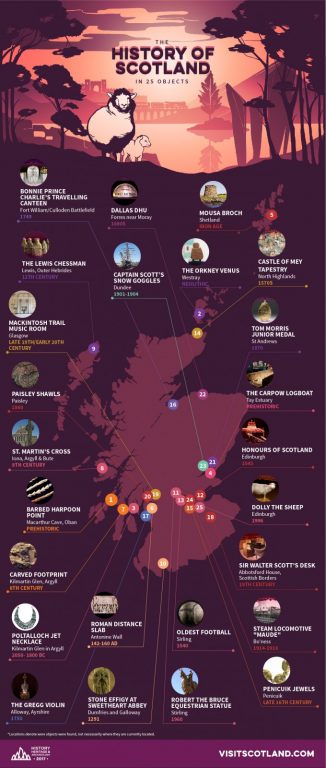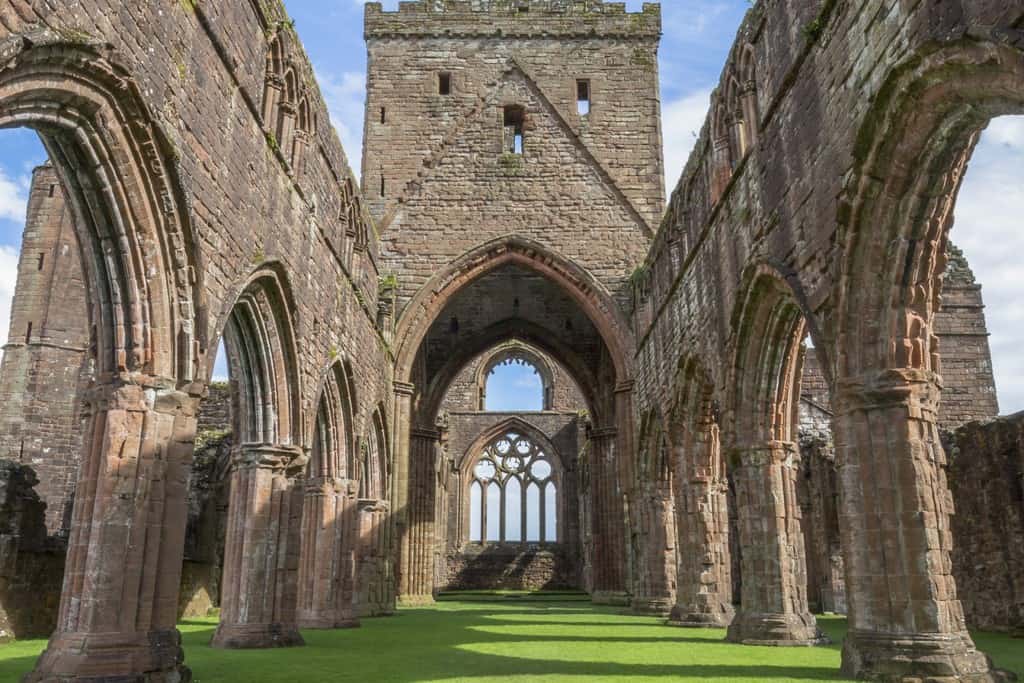A STONE effigy of Lady Dervorgilla of Galloway has been revealed by VisitScotland as one of the top 25 objects to have shaped Scotland’s history in a stunning new e-book.
Other items appearing in the list include a Roman distance slab, a medieval football, Antarctic goggles, a carved footprint and a dancing fiddle.
The stone sculpture can be found upon the grave of Lady Dervorgilla at Sweetheart Abbey, near Dumfries. She was the wife of Lord John Balliol of Barnard Castle, who played a prominent role in Scottish and English politics in the late 13th century. The couple married when she was 13, and with a fortune of her own, she was a powerful woman in her own right.
 On his death in 1268, Lady Dervorgilla had his heart embalmed and placed in an ivory casket which she is said to have taken everywhere with her. When she died, she was laid to rest in front of the abbey’s high altar, still holding on to her husband’s heart, giving it the name of Sweetheart Abbey.
On his death in 1268, Lady Dervorgilla had his heart embalmed and placed in an ivory casket which she is said to have taken everywhere with her. When she died, she was laid to rest in front of the abbey’s high altar, still holding on to her husband’s heart, giving it the name of Sweetheart Abbey.
Compiled by an expert panel for the 2017 Year of History, Heritage and Archaeology, the 25 objects cover over 5,000 years of Scottish history and every region of the country from Shetland to the Scottish Borders.
The objects were chosen based on chronological and geographic spread alongside their individual interesting stories. The final 25 were chosen by a panel that included representatives from Historic Environment Scotland, National Museums of Scotland, Society of Antiquaries of Scotland and VisitScotland.
VisitScotland hopes that visitors will go on a trail this summer to discover as many of the objects as possible and in turn discover more about Scotland’s fascinating past.
The oldest object in the list is a barbed harpoon point (originally found in the Macarthur Cave, Oban) that dates back to the Middle Stone Age, and is one of the earliest instruments used to hunt and fish in Scotland.
The most modern in the list is Dolly the Sheep – the first animal to be cloned from an adult cell – who is currently housed at the National Museum of Scotland in Edinburgh and celebrated her 20th anniversary in 2016
More unusual objects on the list include the Orkney Venus – the earliest known depiction of the female human form – which dates from the Neolithic period and was uncovered at the Links of Noltland on the Orkney island of Westray in 2009.
A violin which ignited Robert Burns’ rebellious streak, revealing more about the great Bard’s personality is another object that makes the final cut. The Gregg Violin was owned by Burns’ dance teacher, William Gregg. In around 1779, Robert Burns started taking dancing lessons and wrote that he hoped these new skills would ‘give my manners a brush’, but it was most likely an act of rebellion because his father did not approve of such seemingly sinful behaviour.
Full list of Scotland’s History in 25 Objects:
- Barbed Harpoon Point
- The Orkney Venus
- Poltalloch Jet Necklace
- The Carpow Logboat
- Mousa Broch
- Roman Distance Slab
- Carved Footprint
- Martin’s Cross
- The Lewis Chessmen
- Stone Effigy at Sweetheart Abbey
- Robert the Bruce Equestrian Statue
- Honours of Scotland
- Oldest Football
- Castle of Mey Tapestry
- Penicuik Jewels
- Bonnie Prince Charlie’s Travelling Canteen
- The Gregg Violin
- Sir Walter Scott’s Desk
- Mackintosh Trail Music Room
- Paisley Shawls
- Tom Morris Junior Medal
- Dallas Dhu Stencil
- Captain Scott’s Snow Goggles
- Steam Locomotive “Maude”
- Dolly the Sheep






